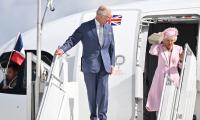India’s case on Kashmir is based on illegal occupation, which is attached to a questionable Instrument of Accession (IOA) supposedly given by Maharaja Hari Singh.
Pakistan’s case, on the other hand, is based on the principle of the ‘right of self-determination’ of the people of Jammu & Kashmir. Pakistan’s principal stand is also substantiated by Nehru’s promise on the floor of the Indian parliament and India’s commitment to the UN Security Council and the resolution passed by UNCIP (1950-51). In short, India’s claim is on the piece of land, and Pakistan’s demand is based on unilateral principles and law. The conflict is between occupation and the rights of people.
History is witness that in the end it is always principle that wins against occupation.
Arms and boots cannot suppress the rights of people. The French got their freedom against monarchy through revolution. No one could stop that. The Russians rebelled against capitalism and deposed the Czars. The South Africans successfully fought against the apartheid. The USA's Declaration of Independence was a result of peoples’ efforts against the mother state of the UK.
Ironically, the entire struggle of the All India Congress and Muslim League is based on the principle of self-determination. It was only according to the wishes of the people that the states of India and Pakistan respectively got their independence.
India’s attempt has always been to somehow keep wrecking the speed and object of the two resolutions. In 1955, a summit took place between Pakistan’s governor-general Ghulam Muhammad and Nehru to find a solution to the Kashmir issue. Nothing happened. However, the answer is found in a confidential note of 1952 by Nehru in which he says that: “Our national interest demands that we should adopt a peaceful policy towards Pakistan and, at the same time, add to our strength. Strength ultimately comes not from the defence forces, but the industrial and economic background behind them. As we grow in strength, and we are likely to do so, Pakistan will feel less and less inclined to threaten and harass us, and a time will come when Pakistan would be forced to settle.”
The Murree Summit between Ayub and Nehru in 1960 also produced no results. According to President Ayub, “Nehru was not interested in finding a solution and whenever I would seek an answer, Pundit Jee would look out the window and remark, ‘How beautiful Murree is’.”
By the time of the Simla Pact (1972), Pakistan had lost East Pakistan and India had more than 80,000 Pakistani POWs. A ceasefire LOC was declared, which the Indians interpret as the line of actual control. But the reality is that this agreement has been overtaken by time and everyone now knows that without Kashmiris no bilateral decision between Pakistan and India can solve the Kashmir issue.
Despite India’s efforts to block a solution, the UN resolutions hence remain alive. The last such attempt was the Agra Declaration. According to General Musharraf, the joint declaration on the solution of Kashmir was imminent but at the last moment again India backed out. Later L K Advani claimed that he had “sabotaged” the Agra Declaration.
Today’s movement in Jammu & Kashmir is the ‘Peoples’ Movement’. The government and the people of Pakistan are convinced that this Peoples’ Movement in Jammu & Kashmir will triumph against the occupation of armed and forcible possession of the territory by India.
Human rights abuses being committed is the final straw in India’s coffin. There is hardly a house in Kashmir that has not felt it or a mother or sister who is not mourning a dead or waiting for loved ones’ return. The list of physical abuses by the Indian armed forces of protesters, civil activists, professors, lawyers, students, and even children are unending.
These include shoot at sight, fake encounters, extrajudicial killings (more than 6500 mass graves have been found), deaths in custody, torture, use of excessive force, pallet guns blinding hundreds permanently, missing persons, forced detention without access to justice or courts for months, no trial, rapes (the Kunan Poshpora case in which 23 Kashmiri women were gang-raped), molestation of women, attempts at dehumanizing the population, lack of access to courts, blackouts, the longest shut-down of the internet and the non-stop lockdown and curfew since August 5, 2019.
Even the victims of Nazi Germany have never faced such atrocities. The largest presence of armed forces including a massive army is present in the territory. The government instructions on the record are not to register cases against security personnel. The Armed Forces Act, 1990 and its infamous Section 7 give extraordinary powers to the Indian occupying forces, including the right to shoot at sight and destroy structures. Indian security personnel are protected against prosecution for human rights violations. Not a single case has been prosecuted so far. This is virtual immunity from action given to the Indian armed forces, a replica of the immunity of Hitler’s SSS.
The revocation of Article 370 of the Indian constitution and the forcible annexation carried out with the support of far-right Hindu extremists, are the final straw and a virtual slap on the face of the international community. India has totally denied justice to the Kashmiris for several decades and ruined millions of lives in the process.
I am convinced that in this time of struggle by the people of JK, the present movement (a legitimate Peoples’ Movement, unarmed and demonstrative) is unstoppable.
My conviction is based on the ground that the blatant genocide by India is producing the worst results for India. Such actions always breed hatred which has fortified the cry for ‘Azaadi’. In Occupied Kashmir, people shout Azaadi even in their dreams. This fire cannot be extinguished. Even US forces had to leave Vietnam and could not suppress peoples’ will. This will happen to India as well.
The greatest thing that Prime Minister Imran Khan with his Foreign Office in the current times has done is to bring back the UN Resolutions to the forefront. India has lost its legitimacy on account of the human rights abuses and it is losing the media war. Trump, Erdogan, Mahathir, the Chinese foreign minister – they are all just a few examples of the world openly talking about the enforcement of UN resolutions on Kashmir.
It is inevitable that the Indian forces will run away from Kashmir as the maharaja did in 1947, and then the legal solution would lie in the honest enforcement of the UN resolutions by the world leadership and mediation either by the UN or other regional or world powers.
Concluded
The writer is a Supreme Court advocate, former federal
minister for law and former president of the SCBA.
Email: ali@mandviwallaandzafar. com
The cases of Attabad Lake and Gwadar simply highlight the many tragedies that exist around the country
Reaffirming loyalty to democracy as a problem solver can be a good starting point
Unfortunately, Pakistani films and TV dramas have seldom ventured beyond domestic intrigues and love triangles
A woman walks past a building of the International Monetary Fund. — AFP/FileThe annual and spring meetings of the...
Late Benazir Bhutto's daughter Asifa Bhutto Zardari addresses the Christian community in Bihar Colony on January 23,...







